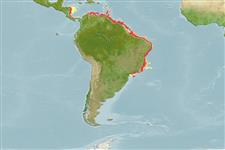>
Carangiformes (Jacks) >
Carangidae (Jacks and pompanos) > Scomberoidinae
Etymology: Oligoplites: Greek, oligos = small + Greek, hoplites = armed (Ref. 45335).
More on author: Cuvier.
Environment: milieu / climate zone / depth range / distribution range
Ecología
marino; agua dulce; salobre bentopelágico; rango de profundidad 18 - 45 m (Ref. 3277). Tropical; 16°N - 26°S, 89°W - 34°W
Western Atlantic: Lake Izabal, Guatemala eastward to Sao Paulo, Brazil.
Tamaño / Peso / Age
Maturity: Lm ? range ? - ? cm
Max length : 49.7 cm TL macho / no sexado; (Ref. 9626); common length : 35.0 cm TL macho / no sexado; (Ref. 9626); peso máximo publicado: 900.00 g (Ref. 9626)
Adults are found mainly in brackish and fresh waters; also over muddy bottoms of coastal marine waters (Ref. 5217). May leap out of the water. They return to the sea to reproduce (Ref. 36880). Dorsal and anal spines bear venomous glands (Ref. 40401). Adults are carnivorous (Ref 40401) while juveniles up to 8.2 cm FL feed mainly on scales taken from larger fishes, also on benthic and planktonic crustaceans, and to a minor extent on smaller fishes and polychaetes (Ref. 40402). Juveniles up to 3.0 cm TL adopt a dark brown color pattern while close to decaying plant fragments, an example of camouflage (Ref. 40401, 46533). Over open, detritus-free and light colored sandy bottom, adopts a contrasting yellowish and dark brown pattern, an example of warning colors. Its conspicuous colors are mimicked by juveniles of the non-venomous grunt Pomadasys ramosus (Ref. 46533).
Life cycle and mating behavior
Maturities | Reproducción | Spawnings | Egg(s) | Fecundities | Larva
Cervigón, F., 1993. Los peces marinos de Venezuela. Volume 2. Fundación Científica Los Roques, Caracas,Venezuela. 497 p. (Ref. 9626)
IUCN Red List Status (Ref. 130435)
Human uses
Pesquerías: escaso valor comercial
Herramientas
Special reports
Download XML
Fuentes de Internet
Estimates based on models
Preferred temperature (Ref.
123201): 24.3 - 28, mean 27.3 °C (based on 60 cells).
Phylogenetic diversity index (Ref.
82804): PD
50 = 0.5312 [Uniqueness, from 0.5 = low to 2.0 = high].
Bayesian length-weight: a=0.01072 (0.00593 - 0.01935), b=2.89 (2.73 - 3.05), in cm total length, based on LWR estimates for this species & Genus-body shape (Ref.
93245).
Nivel trófico (Ref.
69278): 4.3 ±0.5 se; based on diet studies.
Resiliencia (Ref.
120179): Medio, población duplicada en un tiempo mínimo de 1.4-4.4 años (Preliminary K or Fecundity.).
Fishing Vulnerability (Ref.
59153): Moderate vulnerability (40 of 100).
